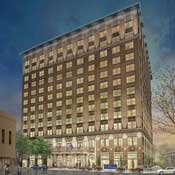Thursday, July 29, 2010
The city of Jackson has two months to spend the remainder of a federal grant aimed at spurring the redevelopment of underused industrial or commercial sites. At a meeting this morning, city officials encouraged property owners and developers to apply for the city's Brownfields Redevelopment Grant Program, which pays for environmental assessments on properties that may be contaminated with hazardous substances or chemicals.
The U.S. Environmental Protection Agency awarded Jackson the $400,000 grant in 2008, and the city has until Sept. 30 of this year to use the money. So far, the city has awarded $180,000 to prospective developers and property owners, according to city Deputy Director for Economic Development Larry Jones.
The grants cover the initial costs of assessing any environmental risks to redeveloping a property, which usually includes a walk-through of the site, research on the property's history and--if necessary--tests of soil and groundwater samples for contamination.
Jones said that the average cost of initial assessments is roughly $4,500, meaning the city can fund evaluations for several more properties with its remaining grant funds.
"Our intent is to spread the money around so we can get the most benefit," Jones said.
Any property in the city that qualifies as a "brownfield" is eligible for the grant. Brownfield is a federal designation for properties whose redevelopment "may be complicated by the presence or potential presence of a hazardous substance, pollutant or chemical," according to the Mississippi Department of Environmental Quality. Former gas stations, manufacturing plants or warehouses all could potentially be brownfield sites.
The brownfield designation emerged in the wake of the federal Superfund law of 1980. The law gave the federal government broad authority to charge current or past owners of environmentally contaminated properties with the cost of cleaning up those sites. While the law helped fund the cleanup of dangerous properties, it also had a chilling effect on redevelopment in urban areas. Faced with a choice between rehabilitating an old, inner-city industrial site--and the possibility of paying for environmental cleanup--or heading to undeveloped areas outside the city, many developers stuck to safer, new properties.
In the early 1990's, the EPA developed the brownfields program to offset the stigma that Superfund had attached to old industrial sites. The program protects property owners and potential developers from liability early in the environmental-assessment process. It also adapts cleanup standards to the intended use of a property: If a brownfield is going to end up as a paved parking lot, the EPA will not hold it to the same cleanup standard as a future nursery school.
The city has already had success redeveloping brownfield sites. The King Edward Hotel qualified, having sat vacant for decades, as did the location of the new federal courthouse and several properties in the Farish Street Entertainment District. In 2002, an inventory compiled by the city listed 147 potential brownfield sites in the city, accounting for roughly one square mile in the city and ranging from less than one acre to more than 740 acres per site.

Comments
Use the comment form below to begin a discussion about this content.
Sign in to comment
Or login with:
OpenID